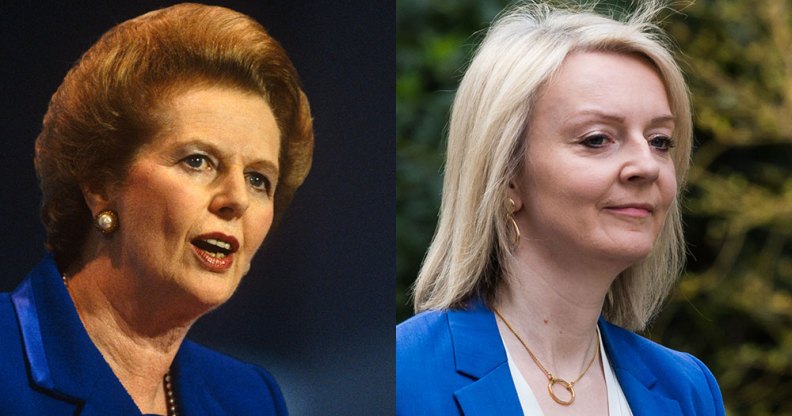On the anniversary of Section 28 coming into law, fears are growing that history is repeating itself

Margaret Thatcher and Liz Truss. (Getty)
Margaret Thatcher and Liz Truss. (Getty)
It’s been 32 years since Section 28 came into law, banning local authorities and schools from the “promotion of homosexuality”, and by proxy, sponsoring discrimination against all queer identities.
The clause – an amendment to the Local Government Act 1988 – was born from a homophobia that had become emboldened during the AIDS crisis, and was a direct response to calls for equality from lesbian and gay rights activists.
Then-prime minister Margaret Thatcher captured and mobilised this hate in her infamous 1987 Conservative Party conference speech, which was met with rapturous applause.
“Children who need to be taught to respect traditional moral values are being taught that they have an inalienable right to be gay,” she said.
“All of those children are being cheated of a sound start in life. Yes, cheated.”
What was Section 28?
When Section 28 was enacted on May 24, 1988, it marked the dawn of a dark new era for LGBT+ children, those from queer families, and Britain’s LGBT+ community at large.
Teachers were forbidden from informing children about LGBT+ people and same-sex relationships, meaning homophobic against both pupils and staff grew out of ignorance.
Councils were prohibited from funding books, plays, leaflets, films or other materials showing same-sex relationships, and LGBT+ youth support groups up and down the nation were shuttered.
The legislation remained in place until 2000 in Scotland and 2003 in England and Wales. Acting Liberal Democrats co-leader Ed Dave, who introduced the clause that led to Section 28’s repeal, recently told PinkNews this left young people feeling “alone and vulnerable”.
“I am proud to have moved the clause that abolished Section 28 once and for all,” Davey said.
“But we still have so far to go. From trans rights, to tackling the persistent discrimination faced by the LGBT+ community: the fight is far from over.”
Indeed, almost two decades after Section 28’s demise, queer youth find themselves under attack once more.

Celebrities help to hold a banner opposing Section 28, at the Lesbian, Gay, Bisexual, and Transgender Pride event, London, 4th July 1998. Those present include (from second left) actor Michael Cashman, comedian Rhona Cameron and activist Peter Tatchell. First and second from right are musician and radio presenter Tom Robinson, and comedian and TV presenter Graham Norton. (Steve Eason/Hulton Archive/Getty Images)
Trans kids in particular find themselves targeted by those who seek to deny them, including – but not limited to – the highest levels of today’s government.
Equalities minister Liz Truss has recently announced worrying plans for trans rights, including restricting access to healthcare for transgender youth, with her plans widely likened to the much-reviled legislation.
Among those to make the comparison is Stonewall, which was set up in 1988 to combat Section 28.
Laura Russell, the charity’s director of campaigns, policy and research, said: “When Stonewall was campaigning to oppose Section 28, we were often told that young lesbian, gay and bi people are impressionable, vulnerable and don’t understand themselves.
“Today, we know this simply isn’t the case and is thankfully something we hear far less often. So we can’t let history repeat itself and a roll back of existing rights happen because the same arguments are now being made about trans people.”
Section 28 prompted massive and visible protests.
The culture war being stoked around trans rights bears terrifying resemblances to the one that took place in 1988.
In the run-up to that year’s general election the Conservatives whipped up fear and hatred, issuing posters claiming that the Labour Party wanted LGBT+ friendly books like Young, Gay and Proud and The Milkman’s on His Way to be read in schools.
The law itself was introduced shortly after the election, and was based on a prior amendment by the Earl of Halsbury that had stalled months before.
Its journey through parliament was met with some of the largest and most memorable displays of queer protest in history.
On February 20, 1988, some 20,000 queer people marched through Manchester city centre against what they recognised as an existential threat – one of the most well-attended LGBT+ demonstrations ever held in the UK.
Days later, as the bill passed in the House of Lords, a group of four lesbians abseiled into the chamber. It made national news broadcasts and to this day remains one of the most notorious acts of protest in British history.
Lesbians frustrated the establishment again the night before Section 28 became law, storming the BBC’s live broadcast of the Six O’Clock News wearing “Stop the Clause” t-shirts.
One woman chained herself to a camera, the other to the newsdesk.
‘The fight is far from over.’
Despite their efforts the law passed, darkening the lives of an entire generation. David Cameron (who voted against the repeal of Section 28 in 2003) apologised for the hateful law in 2009, a year before his election as prime minister.
He admitted he didn’t have a “perfect record” on gay rights, but condemned the law as being “offensive to gay people”.
Now, in 2020, the fight continues.
More than 44,000 people have, at the time of writing, signed a petition opposing Truss’ plans for trans rights.
Meanwhile the trans community and its allies, unable to stage public protests, have launched a letter-writing campaign to the equalities minister, with the aim of informing the government of the fears it has stoked.
The campaign says: “We are being constantly attacked and vilified by the media, politicians and members of transphobic hate groups and we need to speak up against this with one voice.”

